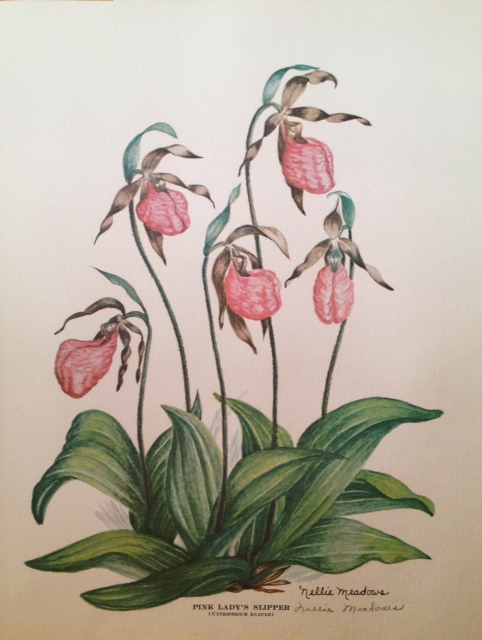Pink Lady Slipper and Native American Legends of the Ladyslipper (Cypripedeum Acaule)
One of America’s more rare and wonderful flowers is the Pink Ladyslipper. It is curiously both beautiful and at the same a whisper of a past we have lost when our continent was covered by plants of the deep, dark woods. This odd little plant is the substance of many varied legends held by native peoples.
It is a stem less perennial clumping herb with two basal, ovalish leaves that are six to eight inches long. The flowers are solitary at the end if scurfy-hairy stalks that are six to ten inches long. The lip of the flowers much enlarged and sac-like in appearance, hence its appearance of a moccasin or ballet slipper. It usually flowers in May to June in dry old growth woods with highly acid soils. Before we go into the substance of those aforementioned legends let’s talk some more about the plant.
Richard Bonnett, Creative Commons via Wikimedia Commons, Orchi - Pink Ladyslippers
It’s botanical name is Cypripedium Acaule from (sip- pri-pee’di-um a-u-calle-aye) both the Latin and Greek roughly translated to mean Venus’ shoe. Among the approximate fifty varieties of lady slippers, the pink is one of the rarest. It was so popular during Victorian times it was actually declared extinct, but that was a misconception based on disappearances in certain areas. So if you are lucky enough to see one in the wild, you should know that they are endangered in some states. They grow primarily under pine trees, red maple trees, and sweetgum trees. You also might find them near greenbrier and sassafras.
This is not a plant to grow in your garden. There are a few very good reasons why and that has to do with in part with symbiotic relationships. The Pink Ladyslipper needs a certain Rhizoctonia fungus and the Bumble bee to exist. With respect to the fungus, the plant and the fungus cannot survive for long without each other. Also it takes many years for the plant to grow from seed.
Native Peoples Folklore and Medicine
Pink Ladyslippers belong to the orchid family and among various Native American tribes it is often simply referred to as the “Moccasin Flower.” It’s easy to see how very “little imagination it would take see the flowers as pretty little pink moccasins worthy of many a romantic tale or two. Additionally, there was a time when eastern North America was home to an abundance of Pink Ladyslippers.
They weren’t just loved for their beauty, they were also an important source of Indian medicines. Native peoples primarily used th Pink Ladyslipper for antispasmodic, nervine and tonic —specifically for treating nervous diseases and hysteria. It is also reported that it relieves pain without being a narcotic and is a treatment for insomnia. Only the rhizome of the plant is used for medicinal purposes. Never pick the plant’s blossom because doing so will interfere with the plants life cycle and it will never flower again or eventually die. That would be a tragedy since a healthy Pink Ladyslipper can live for at least twenty years and some reports much longer.
The Legend of the Pink Ladyslipper Native Folktales
Among several tribes on the North American continent there are romantic tales revolving around the Pink Ladyslipper. The most well known versions originate with the Ojibwe version of the story, in which a young Indian girl embarks on a snow bound, winter journey for desperately needed medicine for her family and tribe. On the journey she loses her moccasins, but continues on bloodying her feet, leaving a trail behind her. In the spring the bloody footprints are replaced by bright pink Ladyslipper orchid and all return to health.
As with most oral tradition native people’s tales, this story changed with the tellers and depending upon which tribe was doing the telling the gist of the story varied. I personally first heard the story from a Kentucky member of the Shawnee tribe, whose grandmother who was of the once nearby Yuchi tribe and passed on the legend of her tribe. It was she who also taught me about the plant’s healing powers. She would make a powder out of the roots and steep it in water to give to her patient. I do not recommend doing this because of the herb’s rarity. I think it is more important to know her tribes alternative tale and honor the plant.
Their version was about an Indian chief who went off to war promising to return with a pair of pink moccasins for his little daughter who was inconsolable at his departure. He was killed in battle and the little girl died of grief. On the girl’s burial site the mother fell asleep and when she woke a pair of Pink Ladyslipper’s marked the spot. In that instant, she knew that both her husband and little girl had been reunited.
Lady Slippers in Florida
Artist: Nellie Meadows, 1973 - Pink Lady Slippers
I am fortunate enough to look at Pink Lady Slippers everyday even though they are not found in Florida. Mine are, of course, in a painting by renowned nature artist, Nellie Meadows. Born in 1915, she was well known for her depictions of flora and fauna in Kentucky, along with having the honor of having her painting “Kentucky the Great State” became the state’s official piece in 1976 at the bicentennial. She was a remarkable artist who was still painting at 91 when she died in 2006.
If You’d Like to Know More About Pink Lady Slippers!
Pink Lady Slippers - Island Creek Ecology


